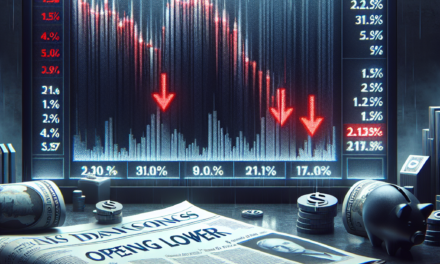“Bitcoin Soars to New Heights: Riding the Wave of Trump-Driven Optimism!”
Introduction
Bitcoin has surged to near $80,000, driven by a wave of optimism linked to former President Donald Trump. This remarkable ascent in Bitcoin’s value reflects a confluence of factors, including heightened investor confidence and speculative interest surrounding Trump’s potential influence on the cryptocurrency market. As digital currencies continue to gain mainstream acceptance, the political and economic implications of Trump’s involvement have sparked renewed enthusiasm among traders and investors, propelling Bitcoin to unprecedented heights. This surge underscores the volatile yet promising nature of cryptocurrencies in the global financial landscape.
Bitcoin’s Surge: Analyzing the Factors Behind Its Near $80,000 Valuation
Bitcoin’s recent surge to nearly $80,000 has captured the attention of investors and analysts alike, prompting a closer examination of the factors driving this remarkable valuation. As the world’s leading cryptocurrency, Bitcoin has often been subject to volatile price swings, influenced by a myriad of economic, political, and technological factors. However, the current optimism surrounding former President Donald Trump appears to be playing a significant role in this latest rally.
To begin with, the political landscape in the United States has always had a profound impact on financial markets, and cryptocurrencies are no exception. The potential return of Donald Trump to the political arena has sparked discussions about regulatory changes that could favor digital currencies. During his presidency, Trump was known for his deregulatory stance, which many believe could extend to the cryptocurrency sector if he were to regain influence. This prospect has fueled investor optimism, as a more favorable regulatory environment could lead to increased adoption and integration of Bitcoin into mainstream financial systems.
Moreover, the anticipation of Trump’s possible influence on economic policies has also contributed to Bitcoin’s upward trajectory. Investors are speculating that a Trump-influenced administration might prioritize economic growth and innovation, potentially leading to policies that encourage investment in digital assets. This speculation has created a sense of bullishness in the market, as investors position themselves to capitalize on potential future gains.
In addition to political factors, the broader economic environment has also played a crucial role in Bitcoin’s recent surge. Inflationary pressures and concerns about the stability of traditional fiat currencies have driven investors to seek alternative stores of value. Bitcoin, often referred to as “digital gold,” has emerged as a popular hedge against inflation, attracting both institutional and retail investors. As inflation rates continue to rise globally, the demand for Bitcoin as a safe-haven asset has intensified, contributing to its price appreciation.
Furthermore, technological advancements and increased adoption of blockchain technology have bolstered Bitcoin’s appeal. The growing acceptance of cryptocurrencies by major financial institutions and corporations has lent credibility to the digital asset space. Companies such as Tesla and Square have made significant investments in Bitcoin, signaling confidence in its long-term potential. This institutional interest has not only provided a price floor but has also encouraged other investors to follow suit, further driving up demand.
Additionally, the ongoing development of Bitcoin’s infrastructure has enhanced its utility and accessibility. Innovations such as the Lightning Network have improved transaction speeds and reduced costs, making Bitcoin more practical for everyday use. As these technological improvements continue to unfold, they are likely to attract a broader user base, thereby increasing demand and supporting higher valuations.
In conclusion, Bitcoin’s approach to the $80,000 mark is the result of a confluence of factors, including political optimism surrounding Donald Trump, economic conditions favoring alternative assets, and technological advancements within the cryptocurrency ecosystem. While the future remains uncertain, the current momentum suggests that Bitcoin’s role as a significant player in the global financial landscape is only set to grow. As investors and analysts continue to monitor these developments, the interplay between political dynamics, economic trends, and technological progress will undoubtedly shape the trajectory of Bitcoin and the broader cryptocurrency market in the coming months.
The Trump Effect: How Political Optimism is Influencing Bitcoin Prices
As Bitcoin approaches the $80,000 mark, a wave of optimism surrounding former President Donald Trump appears to be influencing the cryptocurrency market. This phenomenon, often referred to as “The Trump Effect,” highlights the intricate relationship between political developments and financial markets. While Bitcoin’s price is primarily driven by factors such as supply and demand dynamics, technological advancements, and regulatory changes, political events can also play a significant role in shaping investor sentiment and market trends.
The recent surge in Bitcoin’s value can be attributed, in part, to the anticipation of Trump’s potential return to the political arena. His influence on the market is not entirely surprising, given his history of impacting economic policies and financial markets during his presidency. Trump’s administration was marked by significant tax reforms, deregulation efforts, and a focus on economic growth, which resonated with many investors. As a result, his potential re-entry into politics has sparked renewed interest and optimism among those who view his policies as favorable to economic expansion and innovation.
Moreover, Trump’s stance on cryptocurrencies has evolved over time. Initially skeptical, he has since acknowledged the growing importance of digital currencies in the global financial landscape. This shift in perspective has been well-received by the cryptocurrency community, which views it as a sign of potential regulatory support and mainstream acceptance. Consequently, the prospect of Trump influencing future cryptocurrency policies has contributed to the bullish sentiment surrounding Bitcoin.
In addition to political factors, the broader economic environment has also played a role in Bitcoin’s recent price surge. With inflationary pressures mounting and central banks around the world maintaining accommodative monetary policies, investors are increasingly seeking alternative assets to hedge against currency devaluation. Bitcoin, often referred to as “digital gold,” has emerged as a popular choice for those looking to diversify their portfolios and protect their wealth from inflation. This growing demand for Bitcoin as a store of value has further fueled its upward trajectory.
Furthermore, institutional adoption of Bitcoin continues to gain momentum, with major financial institutions and corporations recognizing its potential as a legitimate asset class. This trend has been bolstered by the increasing number of Bitcoin exchange-traded funds (ETFs) and the integration of cryptocurrencies into traditional financial systems. As institutional investors allocate more resources to Bitcoin, its price is likely to experience continued upward pressure.
While the optimism surrounding Trump and the broader economic environment have contributed to Bitcoin’s rise, it is important to acknowledge the inherent volatility of the cryptocurrency market. Price fluctuations are common, and investors should remain cautious and informed when navigating this rapidly evolving landscape. Nonetheless, the current optimism reflects a growing recognition of Bitcoin’s potential as a transformative force in the financial world.
In conclusion, the interplay between political developments and financial markets is evident in the recent surge of Bitcoin’s value. The optimism surrounding Trump’s potential return to politics, coupled with broader economic factors and institutional adoption, has created a favorable environment for Bitcoin’s ascent towards the $80,000 mark. As the cryptocurrency market continues to evolve, it will be crucial for investors to stay informed and adapt to the changing dynamics that influence Bitcoin’s price movements.
Market Reactions: Investor Sentiment as Bitcoin Approaches $80,000
As Bitcoin approaches the significant milestone of $80,000, the cryptocurrency market is abuzz with optimism, particularly in light of recent developments surrounding former President Donald Trump. This surge in Bitcoin’s value is not merely a reflection of market dynamics but also an indicator of broader investor sentiment, which has been influenced by a confluence of factors, including political developments and economic forecasts. The cryptocurrency’s ascent is emblematic of the growing confidence among investors who view Bitcoin as a hedge against traditional financial systems and a potential safe haven in times of economic uncertainty.
The optimism surrounding Trump, a polarizing figure in American politics, has played a role in shaping market perceptions. His recent statements and actions have reignited discussions about regulatory frameworks and economic policies that could impact the financial landscape. Investors are keenly observing how these developments might influence the cryptocurrency market, particularly Bitcoin, which has often been at the center of regulatory debates. Trump’s influence on market sentiment cannot be understated, as his policies and public statements have historically had a profound impact on investor confidence and market volatility.
Moreover, the anticipation of potential regulatory changes has led to increased interest in Bitcoin as a decentralized asset. Investors are drawn to its promise of financial autonomy and resistance to government intervention, which are particularly appealing in an era marked by economic unpredictability. As traditional markets grapple with inflationary pressures and geopolitical tensions, Bitcoin’s allure as a store of value becomes increasingly pronounced. This sentiment is further bolstered by institutional interest, as major financial entities continue to explore and invest in cryptocurrency, lending it an air of legitimacy that was once elusive.
In addition to political factors, technological advancements within the cryptocurrency space have also contributed to Bitcoin’s upward trajectory. The ongoing development of blockchain technology and the increasing adoption of Bitcoin in various sectors underscore its potential as a transformative financial instrument. These innovations not only enhance the functionality and security of Bitcoin but also expand its applicability, making it an attractive option for a diverse range of investors. As a result, the cryptocurrency market is witnessing a surge in participation from both retail and institutional investors, further driving up demand and, consequently, Bitcoin’s price.
Furthermore, the global economic landscape plays a crucial role in shaping investor sentiment. With central banks around the world grappling with inflation and interest rate adjustments, Bitcoin’s fixed supply and decentralized nature offer a compelling alternative to fiat currencies. This macroeconomic backdrop has heightened interest in Bitcoin as a hedge against currency devaluation and economic instability. Investors are increasingly viewing Bitcoin as a strategic asset that can provide diversification and protection in a volatile economic environment.
In conclusion, as Bitcoin nears the $80,000 mark, the interplay of political, technological, and economic factors is shaping investor sentiment in profound ways. The optimism surrounding Trump, coupled with advancements in blockchain technology and global economic uncertainties, has created a fertile ground for Bitcoin’s continued growth. While the future remains uncertain, the current trajectory suggests that Bitcoin’s role in the financial ecosystem is poised to expand, driven by a confluence of factors that underscore its potential as a revolutionary asset. As investors navigate this evolving landscape, Bitcoin’s journey towards $80,000 serves as a testament to its enduring appeal and transformative potential.
Bitcoin and Politics: Understanding the Connection with Trump’s Influence
As Bitcoin approaches the $80,000 mark, the cryptocurrency market is abuzz with speculation and optimism, much of which is intriguingly linked to the political landscape, particularly the influence of former President Donald Trump. The intersection of Bitcoin and politics is not a novel concept, yet the recent surge in Bitcoin’s value has reignited discussions about how political figures and their policies can impact the cryptocurrency market. Understanding this connection requires a closer examination of the factors at play, including market sentiment, regulatory expectations, and the broader economic environment.
To begin with, the cryptocurrency market is highly sensitive to political developments, and Bitcoin, as the flagship digital currency, often reflects this sensitivity. The recent optimism surrounding Trump can be attributed to several factors. Firstly, Trump’s potential re-entry into the political arena has sparked discussions about deregulation and economic policies that could favor the growth of cryptocurrencies. During his presidency, Trump was known for his deregulatory stance, which many believe could extend to the cryptocurrency sector if he were to regain political influence. This anticipation of a more favorable regulatory environment is a significant driver of the current bullish sentiment in the Bitcoin market.
Moreover, Trump’s influence on Bitcoin is not solely based on policy expectations. His ability to shape public opinion and drive market sentiment cannot be underestimated. As a polarizing figure, Trump’s statements and actions often lead to heightened media attention, which in turn affects investor behavior. The mere possibility of Trump advocating for or against Bitcoin can lead to significant market movements, as investors attempt to anticipate the impact of his influence on the cryptocurrency landscape.
In addition to the direct influence of political figures like Trump, the broader economic environment also plays a crucial role in Bitcoin’s valuation. The ongoing concerns about inflation and the stability of traditional financial systems have led many investors to seek alternative assets, with Bitcoin being a popular choice. The perception of Bitcoin as a hedge against inflation and economic uncertainty has been bolstered by political developments that suggest potential instability in traditional markets. As such, the optimism surrounding Trump is intertwined with a broader narrative of seeking refuge in decentralized financial systems.
Furthermore, the global regulatory landscape for cryptocurrencies is evolving, with many countries grappling with how to integrate digital currencies into their financial systems. The United States, as a major player in the global economy, has a significant influence on these regulatory trends. Trump’s potential impact on U.S. policy could have ripple effects worldwide, affecting how other nations approach cryptocurrency regulation. This interconnectedness highlights the importance of political developments in shaping the future of Bitcoin and other digital assets.
In conclusion, the nearing of Bitcoin to the $80,000 mark amid optimism surrounding Trump underscores the complex relationship between politics and cryptocurrency markets. While the direct impact of political figures like Trump is evident in market sentiment and regulatory expectations, the broader economic context also plays a pivotal role. As investors navigate this intricate landscape, understanding the multifaceted connection between Bitcoin and politics becomes increasingly crucial. The interplay of these factors will likely continue to shape the trajectory of Bitcoin and the cryptocurrency market as a whole, making it essential for stakeholders to remain informed and adaptable in the face of ongoing political and economic developments.
Future Projections: What Bitcoin’s Rise to $80,000 Means for Investors
As Bitcoin approaches the $80,000 mark, investors and market analysts are abuzz with speculation and optimism. This surge in Bitcoin’s value is not only a testament to the cryptocurrency’s resilience but also a reflection of broader economic and political dynamics. The recent optimism surrounding former President Donald Trump, who has been a vocal supporter of cryptocurrencies, has added a new layer of intrigue to Bitcoin’s ascent. Understanding the implications of this rise is crucial for investors looking to navigate the volatile waters of cryptocurrency markets.
To begin with, Bitcoin’s near $80,000 valuation underscores its growing acceptance as a legitimate asset class. Over the past decade, Bitcoin has transitioned from a niche digital currency to a mainstream financial instrument, attracting institutional investors and large corporations. This shift has been driven by a combination of factors, including increased regulatory clarity, technological advancements, and a growing recognition of Bitcoin’s potential as a hedge against inflation. As traditional financial institutions continue to integrate Bitcoin into their portfolios, the cryptocurrency’s legitimacy and stability are further reinforced.
Moreover, the political landscape plays a significant role in shaping market sentiment. The optimism surrounding Donald Trump, who has hinted at a potential return to politics, has invigorated certain segments of the market. Trump’s previous administration was marked by deregulation and a pro-business stance, which many believe could be beneficial for the cryptocurrency sector. His support for digital currencies could lead to more favorable regulatory environments, encouraging further investment and innovation in the space. Consequently, investors are closely monitoring political developments, as they could have profound implications for Bitcoin’s future trajectory.
In addition to political factors, macroeconomic conditions are also influencing Bitcoin’s rise. With global economies grappling with inflationary pressures and currency devaluation, Bitcoin is increasingly viewed as a store of value. Its decentralized nature and limited supply make it an attractive alternative to traditional fiat currencies, which are subject to government manipulation and inflation. As more investors seek refuge in Bitcoin, its demand and price are likely to continue their upward trend.
However, it is essential for investors to remain cautious amid the euphoria. The cryptocurrency market is notoriously volatile, and Bitcoin’s price can fluctuate dramatically in short periods. While the current optimism is driving prices higher, unforeseen events or regulatory changes could quickly alter market dynamics. Therefore, investors should adopt a balanced approach, diversifying their portfolios and staying informed about market trends and potential risks.
Furthermore, technological advancements within the cryptocurrency space are poised to impact Bitcoin’s future. Innovations such as the Lightning Network, which aims to improve transaction speed and scalability, could enhance Bitcoin’s utility and adoption. As these technologies mature, they could further solidify Bitcoin’s position as a leading digital currency, attracting more users and investors.
In conclusion, Bitcoin’s approach to the $80,000 mark is a significant milestone that reflects a confluence of factors, including political optimism, macroeconomic conditions, and technological advancements. For investors, this presents both opportunities and challenges. While the potential for substantial returns is enticing, the inherent volatility of the cryptocurrency market necessitates a cautious and informed investment strategy. As Bitcoin continues to evolve, staying abreast of developments in the political, economic, and technological spheres will be crucial for those looking to capitalize on its growth.
Economic Implications: The Broader Impact of Bitcoin’s Climb on Global Markets
As Bitcoin approaches the $80,000 mark, the global financial landscape is witnessing a significant shift, driven by a confluence of factors that extend beyond mere market speculation. The cryptocurrency’s ascent is not only a testament to its growing acceptance but also a reflection of broader economic implications that are reshaping global markets. This surge in Bitcoin’s value is occurring amidst a backdrop of optimism surrounding former President Donald Trump, whose influence on economic policies and market sentiment continues to be profound.
To understand the broader impact of Bitcoin’s climb, it is essential to consider the underlying factors contributing to this phenomenon. One of the primary drivers is the increasing institutional adoption of Bitcoin, which has lent the cryptocurrency a degree of legitimacy previously unseen. Major financial institutions and corporations are now integrating Bitcoin into their portfolios, signaling a shift in how digital assets are perceived. This institutional interest is further bolstered by the perception of Bitcoin as a hedge against inflation, particularly in an era where traditional fiat currencies are experiencing volatility.
Moreover, the optimism surrounding Trump plays a crucial role in this economic narrative. His potential return to the political arena has sparked discussions about deregulation and tax reforms, which are perceived as favorable to business and investment. This sentiment has, in turn, fueled confidence in alternative assets like Bitcoin, which are often seen as vehicles for preserving wealth in uncertain times. The anticipation of policies that could stimulate economic growth and reduce regulatory burdens has created a fertile ground for Bitcoin’s rise.
Transitioning to the global markets, the implications of Bitcoin nearing $80,000 are multifaceted. On one hand, the cryptocurrency’s surge is prompting central banks and financial regulators worldwide to reassess their stance on digital currencies. Countries are now exploring the development of their own central bank digital currencies (CBDCs) to maintain control over monetary policy and financial stability. This shift towards digital currencies is indicative of a broader transformation in the global financial system, where traditional banking models are being challenged by decentralized technologies.
Furthermore, Bitcoin’s rise is influencing investor behavior across various asset classes. As more investors flock to Bitcoin, there is a noticeable impact on traditional markets, including equities and commodities. The allure of high returns from cryptocurrencies is drawing capital away from conventional investments, leading to fluctuations in stock markets and commodity prices. This reallocation of assets underscores the interconnectedness of global markets and highlights the need for investors to adapt to an evolving financial landscape.
In addition, the environmental concerns associated with Bitcoin mining are gaining prominence as the cryptocurrency’s value climbs. The energy-intensive nature of Bitcoin mining has sparked debates about its sustainability and environmental impact. As Bitcoin continues to gain traction, there is increasing pressure on the industry to adopt greener practices and technologies. This environmental dimension adds another layer of complexity to the economic implications of Bitcoin’s rise, as stakeholders balance the benefits of digital currencies with their ecological footprint.
In conclusion, Bitcoin’s approach to the $80,000 threshold is emblematic of a broader economic shift that is influencing global markets. The interplay between institutional adoption, political optimism, and regulatory developments is shaping the future of finance. As Bitcoin continues to capture the attention of investors and policymakers alike, its impact on the global economy will likely be profound and enduring, prompting a reevaluation of traditional financial paradigms and paving the way for a new era of digital finance.
Risk and Reward: Navigating the Volatility of Bitcoin in a Politically Charged Environment
As Bitcoin approaches the $80,000 mark, the cryptocurrency market is abuzz with excitement and speculation. This surge in value is not only a testament to Bitcoin’s inherent volatility but also a reflection of the broader economic and political landscape. The recent optimism surrounding former President Donald Trump has added a new layer of complexity to the already intricate world of cryptocurrency trading. Understanding the interplay between political developments and Bitcoin’s price movements is crucial for investors navigating this volatile environment.
Bitcoin’s rise to near $80,000 is emblematic of its unpredictable nature, characterized by dramatic price swings that can occur within short periods. This volatility is both a risk and an opportunity for investors. On one hand, the potential for significant returns attracts those willing to embrace the uncertainty. On the other hand, the same volatility can lead to substantial losses, making it imperative for investors to exercise caution and employ sound risk management strategies. The current political climate, particularly the renewed focus on Donald Trump, adds another dimension to this already complex equation.
The optimism surrounding Trump stems from his potential influence on economic policies and regulatory frameworks that could impact the cryptocurrency market. Trump’s previous administration was marked by a deregulatory stance, which many believe could be favorable for the growth of digital currencies. As speculation mounts about his possible return to political prominence, investors are keenly watching for any signals that could indicate a shift in regulatory attitudes towards cryptocurrencies. This anticipation has contributed to the recent surge in Bitcoin’s value, as market participants position themselves to capitalize on potential policy changes.
However, it is essential to recognize that political developments can have unpredictable effects on the cryptocurrency market. While some investors view Trump’s potential influence as a positive catalyst, others remain cautious, aware that political dynamics can shift rapidly. The intersection of politics and cryptocurrency is fraught with uncertainty, as regulatory decisions can significantly impact market sentiment and, consequently, Bitcoin’s price. Therefore, investors must remain vigilant, continuously monitoring political developments and their potential implications for the cryptocurrency landscape.
Moreover, the broader economic context cannot be overlooked when considering Bitcoin’s recent price movements. Inflationary pressures, monetary policy decisions, and global economic trends all play a role in shaping investor sentiment towards cryptocurrencies. As traditional financial markets grapple with these challenges, Bitcoin is often viewed as a hedge against economic instability. This perception has contributed to its appeal, driving demand and pushing prices higher. However, it also underscores the importance of understanding the multifaceted factors that influence Bitcoin’s value.
In conclusion, Bitcoin’s approach to the $80,000 threshold amid optimism surrounding Trump highlights the intricate relationship between political developments and cryptocurrency markets. While the potential for significant returns is enticing, investors must navigate the inherent volatility with caution. The interplay between political dynamics, regulatory considerations, and broader economic trends creates a complex environment that requires careful analysis and strategic decision-making. As Bitcoin continues to capture the attention of investors worldwide, understanding the risks and rewards associated with this digital asset is paramount for those seeking to thrive in a politically charged environment.
Q&A
1. **What is the current price of Bitcoin?**
Bitcoin is nearing $80,000.
2. **What is driving the optimism around Bitcoin’s price increase?**
Optimism is surrounding former President Donald Trump.
3. **How has Trump’s influence affected Bitcoin’s market?**
Trump’s influence has contributed to positive sentiment and increased investor confidence.
4. **What are analysts saying about Bitcoin’s price trend?**
Analysts are noting a bullish trend and predicting potential further gains.
5. **Are there any specific events linked to Trump that are impacting Bitcoin?**
Specific events related to Trump are not detailed, but his influence is noted as a factor.
6. **How are investors reacting to Bitcoin’s price movement?**
Investors are showing increased interest and enthusiasm, contributing to the price rise.
7. **What are the potential risks associated with Bitcoin’s current price surge?**
Potential risks include market volatility and the possibility of a price correction.
Conclusion
Bitcoin’s approach to the $80,000 mark reflects a significant surge in investor optimism, potentially influenced by political developments such as those surrounding former President Trump. This optimism may be driven by expectations of favorable regulatory changes, increased institutional adoption, or broader acceptance of cryptocurrencies as a legitimate asset class. The rally underscores Bitcoin’s volatility and its sensitivity to external factors, highlighting both the opportunities and risks inherent in the cryptocurrency market. As Bitcoin continues to gain traction, its role in the global financial system may further evolve, attracting both traditional investors and new market participants.





